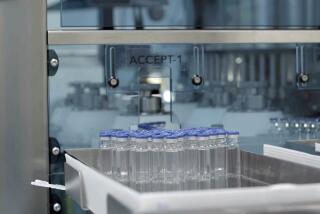Artificial Hearts Endorsed by Federal Advisory Panel : Development of Battery-Powered Device Urged So Patient Can Carry on Normal Life
- Share via
WASHINGTON — A federal advisory panel strongly endorsed the artificial heart program and recommended that efforts be intensified to develop a battery-powered, fully implantable artificial heart that would not require a patient to be “tethered” to an outside power source, government officials said Friday.
Current implants such as the Jarvik-7 artificial heart--which must be sustained by a bedside machine--”provide useful information on patient response and management,” according to a report by the panel, a group of non-government medical specialists appointed by the National Heart, Lung and Blood Institute. But, the report noted, current implants are deficient because they do not allow a patient to carry on relatively normal activity.
Such implants are “but a step” toward the development of totally implantable devices “that we believe are the only systems with long-range promise,” the study said.
‘Ambiguous Benefit’
Although implants such as the Jarvik-7 extend life, the report said, this could be an “ambiguous benefit” because “the life extended may be . . . compromised by pain, distress or incapacity.” Thus, it said, artificial hearts should not become standard therapy “unless they extend expectancy of a life which is, by and large, worth living.”
The study, released Thursday, concluded that fully implantable systems could provide “a significant increase” in life span with an “acceptable quality of life” for an estimated 17,000 to 35,000 patients annually.
Dr. Peter L. Frommer, deputy director of the institute, said Friday that the panel’s recommendations have been approved by the 18-member advisory council that oversees the federal research agency.
The institute’s program “has not focused on total artificial hearts for more than a decade,” he said, and instead has concentrated on developing fully implantable “ventricular assist devices,” or auxiliary pumps, which aid--but do not replace--the natural heart.
Funding Urged
The panel recommended that this program and others studying mechanical circulatory systems continue, but it urged that funding for the development of a total, implantable long-term artificial heart be added and “actively pursued.”
Dr. Gerson Rosenberg, who is working on a totally implantable device at Pennsylvania State University’s Hershey Medical Center, said that he is pleased by the panel’s conclusions.
“If this ultimately leads to increased funding, you’ll see these devices in clinical (human) uses much sooner,” he said Friday.
Rosenberg, whose device is considered among the most advanced, estimated that it would take six to 10 years before such a heart could be implanted in a human. Hershey’s experimental electric heart--run by a small portable power supply worn around the waist or carried on the shoulder--has been successfully implanted in a calf for 222 days, the longest an animal has survived with such a device.
DeVries ‘Encouraged’
Dr. William C. DeVries, who has implanted the Jarvik-7 in four patients, two of whom survive, said that he was “encouraged” by the panel’s support of the program but refused to elaborate until he sees the report.
The panel estimated that a totally implantable heart would cost $150,000 over a survival period of 4 1/2 years, comparable to the costs incurred for such procedures as heart transplants and kidney dialysis.
In one recommendation--described by Frommer as “a rather novel statement not usually heard from those involved in medical research and medical care”--the panel urged that cost effectiveness be an “essential ingredient” in decisions on medical care and reimbursement. It should “be applied generally in the field of medicine and not only to highly visible technologies,” the panel said.






